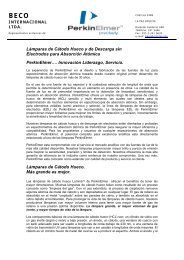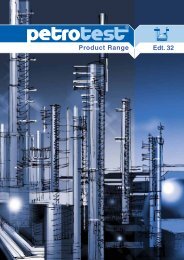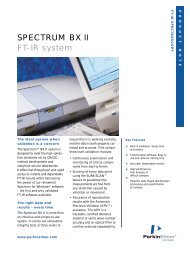General Catalogue Chemistry - BECO Internacional LTDA.
General Catalogue Chemistry - BECO Internacional LTDA.
General Catalogue Chemistry - BECO Internacional LTDA.
Create successful ePaper yourself
Turn your PDF publications into a flip-book with our unique Google optimized e-Paper software.
667 320<br />
Dewar flask<br />
Silver finish, with protective casing, for<br />
maintaining a constant temperature, e.g. in<br />
calorific experiments.<br />
Capacity: 500 ml<br />
Diameter: 70 mm<br />
Height: 210 mm<br />
Weight: 1.0 kg<br />
667 319<br />
Dewar flask<br />
Silver finish, with protective casing,<br />
for experiments using the magnetic stirrer.<br />
Capacity: 500 ml<br />
Diameter: 70 mm<br />
Height: 210 mm<br />
Weight: 1.0 kg<br />
667 321<br />
Plastic lid<br />
With stirrer and borehole for a thermometer, fits<br />
the Dewar flasks (> 667 320 and<br />
> 667 319). The lid serves as a holder for a<br />
thermometer and reduces the exchange of<br />
heat energy with the surroundings.<br />
Diameter: 85 mm<br />
Weight: 0.2 kg<br />
All that is needed to conduct simple experiments<br />
in calorimetry is an insulating flask (Dewar<br />
flask) which reduces to a minimum the exchange<br />
of thermal energy with the environment,<br />
a plastic insert with a lid that holds the thermometer<br />
and the stirrer used for manual agitation.<br />
A magnetic stirrer may also be employed when<br />
using the special, flat-bottomed version of the<br />
Dewar flask.<br />
Application examples for a calorimeter which is<br />
assembled using > 667 321 along with<br />
> 667 319 or > 667 320 include:<br />
• Measuring the heat of solution<br />
• Measuring the heat of neutralization<br />
• Measuring the heat of reaction in solutions<br />
Stoichiometry<br />
The subject of stoichiometry deals with the<br />
quantitative description of chemical reactions.<br />
It is based on the realization that chemical elements<br />
will react one with another only in certain,<br />
constant proportions (law of constant proportions).<br />
Consequently the final product of the<br />
reaction - the chemical compound - always consists<br />
of a constant share of the initial substances,<br />
regardless of the quantities which were available.<br />
Based on this fundamental law, conclusions can<br />
be drawn regarding the relative masses of the<br />
reactants involved, allowing us, for instance,<br />
to calculate the yield factor for a reaction.<br />
One of the elementary experiments in stoichiometry<br />
is the quantitative synthesis of water, the<br />
complement to the water analysis experiments<br />
using Hofmann's electrolysis setup.<br />
This experiment demonstrates that the reactants,<br />
hydrogen and oxygen, join in a precise stoichiometric<br />
ratio of 2:1 to form water (H2O). Gravimetric<br />
examination of the water thus formed<br />
allows us to derive information on the molar<br />
mass of water.<br />
The reaction vessel for stoichiometry also permits<br />
the determination of the relative atomic<br />
mass and the valence of metals.<br />
668 802<br />
<strong>Chemistry</strong> demonstration experiments<br />
“<strong>General</strong> chemistry”<br />
216 pages, DIN A 4<br />
Demonstration experiments from the area of<br />
general chemistry based on the <strong>Chemistry</strong><br />
Panel System. The equipement list of the<br />
experiments also takes account of conventional<br />
stand material<br />
667 320<br />
664 097<br />
Stoichiometric reaction vessel<br />
Metals react with water or acids in the stoichiometric<br />
reaction vessel, developing hydrogen<br />
while doing so. The atomic weight and the chemical<br />
valence of the metal can be determined<br />
on the basis of the volume of the gas collected<br />
in a gas syringe and the preweighed metal<br />
mass. The lower portion of the vessel is first<br />
filled with water or acid, the vessel is then<br />
purged with a non-reactive gas (N 2 ) and, after a<br />
gas syringe has been attached to the reaction<br />
vessel, the reaction is started by lowering the<br />
plunger. The reaction then proceeds calmly,<br />
without flames being produced.<br />
Glass with lateral connection (GL 18) and<br />
three-way stopcock at the lower end<br />
Height: 225 mm<br />
Diameter: 60 mm<br />
Weight: 0.22 kg<br />
analysis methods<br />
Calorimetry<br />
667 321<br />
664 097<br />
LEYBOLD DIDACTIC · GENERAL CATALOGUE CHEMISTRY<br />
71






